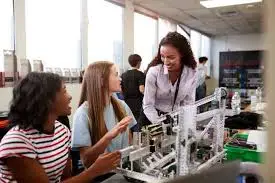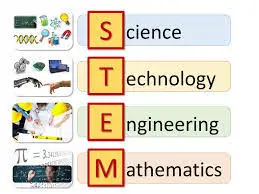Introduction
Ever wondered why kids remember a science experiment they did in school but forget the formula they crammed the night before the test? It’s because hands-on learning sticks. That’s where Maker Education comes into play—a revolutionary approach that’s turning classrooms into innovation hubs. By combining creativity, critical thinking, and collaboration, Maker Education is reshaping how students learn STEM (Science, Technology, Engineering, and Math) subjects.
What Is Maker Education?

Maker Education is an educational philosophy that emphasizes hands-on learning through creative projects. It allows students to design, prototype, and build, fostering a culture of innovation. The approach is rooted in the “Maker Movement”, a global trend celebrating DIY culture and technological tinkering.
Unlike traditional teaching methods, Maker Education encourages students to experiment, fail, and learn from their mistakes. Think of it as the bridge between theoretical concepts and real-world application.
Why Maker Education Matters in STEM
STEM fields thrive on problem-solving and innovation—two areas where Maker Education excels. Here’s why Maker Education is a game-changer:
- Real-World Skills: It equips students with technical skills like coding, electronics, and 3D printing.
- Creative Thinking: Maker projects inspire out-of-the-box thinking.
- Teamwork: Students often collaborate on projects, mimicking real-world engineering teams.
- Confidence Building: Completing hands-on tasks boosts self-esteem and fosters a growth mindset.
Key Components of Maker Education
To integrate Maker Education effectively, it’s crucial to understand its core elements:
1. Hands-On Learning
Learning by doing is the cornerstone of Maker Education. Students engage in activities like building robots, crafting wind turbines, or coding apps.
2. Interdisciplinary Approach
Maker projects often combine elements of science, technology, art, and math, creating a holistic learning experience.
3. Student-Centered Learning
Unlike traditional methods, Maker Education puts students in the driver’s seat. They identify problems, brainstorm solutions, and execute their ideas.
Benefits of Maker Education in STEM
1. Enhanced Engagement
Who wouldn’t want to design a rocket instead of just reading about Newton’s laws? Maker Education makes learning fun and engaging.
2. Improved Retention
When students apply concepts practically, they’re more likely to remember them.
3. Encourages Innovation
Maker Education cultivates a mindset of curiosity and experimentation.
4. Bridges the Gender Gap in STEM
By making STEM more accessible and less intimidating, Maker Education can inspire more girls to pursue careers in these fields.
Tools and Technologies in Maker Education
The right tools can make or break your Maker Education program. Here’s a rundown of essentials:
1. 3D Printers
Perfect for prototyping and teaching engineering principles.
2. Coding Platforms
Scratch and Arduino are excellent for introducing programming.
3. Electronics Kits
Kits like LittleBits and Raspberry Pi are great for hands-on electronics projects.
4. Laser Cutters
These add precision to designs and are excellent for more advanced projects.
Steps to Incorporate Maker Education into the Curriculum
Step 1: Assess Your Resources
Start by evaluating your school’s existing tools and spaces. Do you have a computer lab that can double as a maker space?
Step 2: Get Teacher Buy-In
Teachers need training and resources to feel confident in implementing Maker Education. Consider workshops or online courses.
Step 3: Start Small
Pilot a simple project, like building paper circuits or coding a basic app.
Step 4: Integrate with Existing Subjects
Tie Maker projects to your current STEM curriculum. For instance, a lesson on geometry could include designing 3D models.
Step 5: Gather Feedback
After each project, collect feedback from students and teachers to refine your approach.
Maker Education in Action: Examples of STEM Projects
1. Build a Solar-Powered Car
Students can learn about renewable energy, physics, and engineering.
2. Create a Weather Station
Combine coding and data analysis by building a device to track weather patterns.
3. Design a Prosthetic Hand
A powerful project that blends biology, engineering, and empathy.
4. Develop a Game App
Introduce students to coding and game design principles.
Overcoming Challenges in Maker Education
Every new approach has its hurdles. Here’s how to tackle them:
1. Budget Constraints
Start with low-cost materials like cardboard, recycled items, or simple electronics kits.
2. Time Management
Integrate Maker projects into existing STEM lessons rather than treating them as add-ons.
3. Teacher Training
Provide accessible training resources to equip educators with the skills they need.
The Role of Maker Spaces
A Maker Space is the heart of Maker Education. These dedicated areas are stocked with tools and materials for hands-on projects. But don’t worry if your school lacks a formal maker space—classrooms, libraries, or even hallways can be transformed with a little creativity.
Fostering a Maker Mindset
A Maker Mindset goes beyond projects; it’s about cultivating curiosity and resilience. Encourage students to ask questions, take risks, and view failure as a stepping stone to success.
Maker Education Beyond STEM
While STEM is the natural fit for Maker Education, its principles can be applied to other subjects too:
- History: Recreate ancient tools or models.
- Literature: Build dioramas of story settings.
- Art: Integrate technology like light sculptures or robotic art.
How to Measure Success in Maker Education
Traditional tests may not capture the full impact of Maker Education. Consider alternative assessments like:
- Project Portfolios: Document students’ progress and final products.
- Peer Reviews: Let students present and critique each other’s work.
- Self-Reflection: Encourage students to evaluate their learning journey.
Building Community Support for Maker Education
Involve parents, local businesses, and community organizations to support your Maker Education initiatives. Host maker fairs or open houses to showcase students’ work and generate enthusiasm.
The Future of STEM Learning with Maker Education
As technology evolves, Maker Education will play a pivotal role in preparing students for future careers. By blending creativity with technical skills, this approach ensures that students are ready to tackle tomorrow’s challenges.
Conclusion
Incorporating Maker Education into your curriculum is not just an option—it’s a necessity for modern STEM learning. By engaging students in hands-on projects, you’re not just teaching them; you’re empowering them to innovate, collaborate, and thrive in a rapidly changing world. So, what are you waiting for? It’s time to make some makers.
Check out; A Guide to Finding Your Dream Pet-Friendly 1-Bedroom Apartment
FAQs
1. What is Maker Education?
Maker Education is a hands-on learning approach that integrates creativity, critical thinking, and practical projects into the classroom.
2. Why is Maker Education important for STEM?
It enhances engagement, fosters innovation, and helps students apply theoretical concepts in real-world scenarios.
3. Do Maker projects require expensive tools?
Not necessarily. Many projects can be done with low-cost materials like cardboard, recycled items, or simple electronics kits.
4. How can teachers prepare for Maker Education?
Teachers can attend workshops, take online courses, or collaborate with peers to gain the necessary skills.
5. Can Maker Education be applied to non-STEM subjects?
Absolutely! Maker principles can enhance learning in subjects like history, literature, and art through creative, project-based activities.


